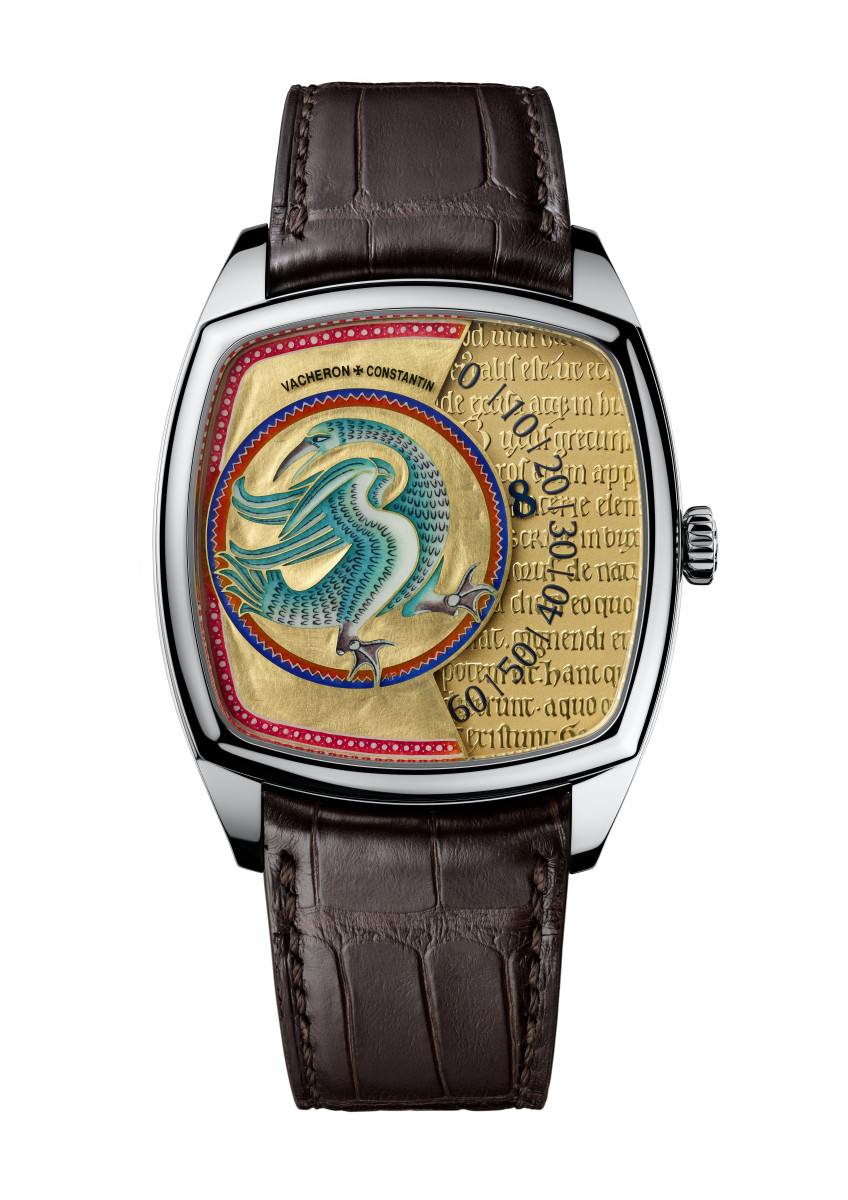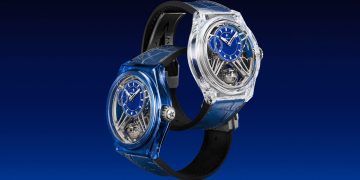Source: Images and content by Vacheron Constantin
http://content.presspage.com/uploads/1999/3a60f935-9360-4d9c-82e7-737c9cdef7b1/500_vac-pr-retrograde-11949v402253.jpg?10000
- Exhibition from 20 February to 04 March 2024, located in the boutique in Madrid (C/ Serrano 68)
- The retrograde indications, which have been present since the 18th century, reflect Vacheron Constantin’s expertise in watchmaking complications.
- To illustrate this distinctive feature of Vacheron Constantin, a selection of models with retrograde indications spanning more than two centuries of history is presented.
Retrograde indications, which appeared in the 18th century and are sometimes accompanied by protruding indications, represent a technical challenge requiring extreme precision. The watches selected from Vacheron Constantin’s private collection, on display from 20 February to 04 March 2024, pay tribute to the expertise that the brand has been cultivating for over two centuries in the field of retrograde indications.
The history of retrograde indications dates back to the 18th century and involves the indicator not making a complete turn of the dial, but returning to its starting point and starting to move again after having travelled its entire measuring segment. This aspect has always represented a technical difficulty requiring extreme precision, something that the Maison has made a distinctive feature of since 1824, including protruding indications on pocket watches.
Vacheron Constantin perfected its technique over the course of a century to be able to equip its wristwatches with retrograde indications, giving the Maison a special know-how in the field of horological complications and making them part of its current collections.
The exhibition pays tribute to Vacheron Constantin’s technical mastery over more than two centuries of history through models with retrograde indications specifically and special indications more generally.
Following the success achieved with the development of retrograde indications, the Maison now has models that include this complication in its Traditionnelle or Overseas collections, notably the Traditionnelle tourbillon openface watch with retrograde date or the Overseas moonphase watch with retrograde date.
Gentleman’s pocket watch in yellow gold with rampant chronograph – 1894
The chronograph first appeared at the beginning of the 19th century as a counter of thirds and was subsequently joined by numerous innovations, such as the rampant function for calculating split times. The split-seconds counter was created in 1831 by the Austrian Joseph-Thadeus Winnerl with a single-hand system and improved in 1838 with the addition of an extra hand. These early mechanisms were created for a clientele interested in adventure, speed and sporting competitions, such as an 1889 order from a client in Buenos Aires interested in horse racing for a chronograph with a rampant seconds hand, or the 1922 request from the famous set designer Edgar Wallace (creator of the film King Kong) for a personalised model of chronograph with a bassine-type rampant seconds hand in polished 18-carat gold.
Mechanically, the rampant function is much more complex than a simple chronograph because it is equipped with a second disengagement system with clamps to bring the chronograph wheel and pinion into contact with or separate them from the same parts located on the rampant hand. In addition, the hand is repositioned by a spring which is loaded by the chronograph.
Gentleman’s pocket watch “Arms in the air” in yellow gold – 1931
At the beginning of the 20th century, the art deco movement was in full swing and creative minds were at work creating imaginative dials and cases with retrograde indications. At Vacheron Constantin, these novelties appeared almost simultaneously on table clocks (1920s), pocket watches (1930s) and wristwatches (1935) and have become a distinctive feature of the Maison, forming part of its current collections.
The pocket watch in question is a bi-retrograde model and is the perfect example of the aesthetic freedom offered by special indications. The dial depicts a Hindu magician whose arms indicate the hours and minutes in two graduated segments on either side, and as time progresses he adopts different postures, reminiscent of the automatons that were so fashionable at the time. Historically, in addition to cyclical retrograde time indicators (hours, minutes, seconds or dates), there are also “sweep” retrograde indicators such as power-reserve indicators.
Gentleman’s pocket watch in yellow gold with rampant chronograph – 198
This pocket-watch model, through its Reference 57260, represents the quintessence of retrograde indications due to its rampant chronograph with double retrograde indication, being one of its 57 horological complications.
It is crafted in 18-carat yellow gold, with a white enamelled dial, manual winding, perpetual calendar and minute repeater.
Gentleman’s wristwatch Saltarello, Model 43041 – 2000
The Saltarello model was first presented in 1997 at the “Watches & Jewels” event in Berlin and has become one of Vacheron Constantin’s most iconic models, accentuating one of the Maison’s hallmarks: inventing new ways of displaying the time, in this case taking inspiration from lift indicators to show the floor.
The time is displayed in a window at 12 o’clock on the dial, while a retrograde hand indicates the minutes and moves along the graduated arc from 0 to 60, then jumps back and starts again (a system patented by Vacheron Constantin). The self-winding Model 43041 also features a soft cushion-shaped case and a pink gold dial with a guilloché finish. This is a limited edition of 500 pieces (200 in white gold, 100 in yellow gold and 200 in pink gold).
Gentleman’s wristwatch The Mercator, Model 43050 – 2001
A tribute to the geographer Gerard Mercator, it reproduces the maps of Europe drawn by him in the 16th century on its Grand Feu polychrome enamelled dial, using the cloisonné technique. It features an ultra-thin Calibre 1120 which began to be marketed in 1967 and comprises one of the thinnest automatic movements in the world due to its 2.45 mm thickness. It also features a double retrograde hours and minutes indication in continuous movement.
The inspiration for this watch is to be found in the “arms-in-the-air” indications typical of the early 20th century, but integrated into the volume in a more reduced form to fit the wrist. Its retrograde compass-shaped hands were specially designed for this collection and the positioning of its axis at 12 o’clock perfectly evokes the instrument used throughout the cartographer, mathematician and geographer’s life.
Ladies’ wristwatch, Model 83570 – 2014
This model belonging to the Traditionnelle collection is the ultimate expression of the strict tradition of Geneva Haute Horlogerie inherited in the 18th century. Imbued with history and rigorous discipline, the Traditionnelle collection displays great technical refinement and pays tribute to the manual decorative techniques handed down from generation to generation.The watch is crafted in 18-carat white gold and is set with 81 brilliant-cut diamonds and a high-precision moon phase, located in the centre of its mother-of-pearl dial, which only needs to be adjusted every 122 years.
Gentleman’s wristwatch Savoirs Enluminés – 2015
The Savoirs Enluminés model is part of the Métiers D’Art collection and forms a unique edition of only 60 examples. It invites you on a voyage of discovery to the heart of the Middle Ages, inspired by the Bestiary of Abedeen, an ancient Celtic manuscript that is internationally renowned for the exquisite quality of its miniatures. This particular model called “Alcyon” pays homage to Water, representing a seabird that builds its nest in the sea and symbolises serenity. Its dial is decorated with the art of Grand Feu enamel and also with the technique of engraving in the form of a delicate phrase with gold shading and texturing.
Its patented mechanism has a continuously variable hour indicator and the three spokes of the hour wheel extend into a carousel, each supporting four hour numerals, the direction of which is determined by a Maltese cross-shaped cam. The hour slides progressively downwards before disappearing after crossing the 60th minute index and giving way to the next hour numeral.
……………………….
Vacheron Constantin Boutique Madrid
Serrano 68 Street
28001, Madrid, Spain








